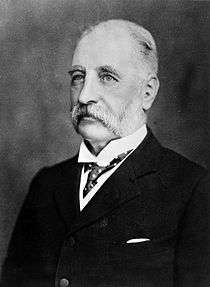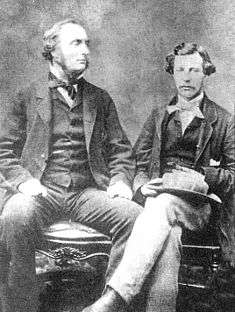James Hector
| Sir James Hector KCMG | |
|---|---|
 | |
| Born |
16 March 1834 Edinburgh, Scotland |
| Died |
6 November 1907 (aged 73) Lower Hutt, New Zealand |
| Nationality | Scottish |
| Occupation | Geologist, naturalist, surgeon |
| Known for | Palliser's expedition, New Zealand Geological Survey |
| Spouse(s) | Maria Georgiana Monro |
| Children | Barclay, Charles Monro, Constance Margaret, David Carmichael, Douglas, Lyell, Georgina, and Marjorie |
| Relatives | David Monro (father-in-law), Charles Monro (brother-in-law) |
| Awards |
Lyell Medal (1877) Clarke Medal (1887) |
Sir James Hector KCMG FRS FRSE(16 March 1834 – 6 November 1907) was a Scottish geologist, naturalist, and surgeon who accompanied the Palliser Expedition as a surgeon and geologist.[1] He went on to have a lengthy career as a government employed man of science in New Zealand, and during this period he dominated the Colony's scientific institutions in a way that no single man has since.
Early life
He was born at 11 Danube Street in Stockbridge, Edinburgh[2] the son of Alexander Hector WS and his wife, Margaret Macrostie.[3]
He attended the Edinburgh Academy from 1844 to 1845. At 14, he began articles as an actuary at his father's office. He joined University of Edinburgh as a medical student and received his medical degree in 1856 at the age of 22.
Palliser expedition
Shortly after receiving his medical degree, upon the recommendation of Sir Roderick Murchison – director-general of the British Geological Survey – Hector was appointed geologist on the Palliser Expedition under the command of John Palliser. The goal of the Palliser expedition to British North America (now Canada) was to explore new railway routes for the Canadian Pacific Railway and to collect new species of plants.

In 1858, when Palliser's expedition was exploring a mountain pass near the continental divide of the Canadian Rockies, one of Hector's packhorses fell into the river. As it was being pulled from the water, his own horse strayed and, when chasing after it, Hector records, he was kicked in the chest and knocked unconscious. He wrote in his diary of the expedition: "In attempting to recatch my own horse, which had strayed off while we were engaged with the one in the water, he kicked me in the chest". His companions, thinking him dead, dug a grave for him and prepared to put him in. His premature burial was cancelled when he regained consciousness. The pass and nearby river have been known since as Kicking Horse Pass and Kicking Horse River.[4]
The legend of the Kicking Horse is now firmly established in popular Canadian history. However, as politely noted by the Palliser scholar Irene Spry, it "embodies Hector's not always accurate reminiscences about the Expedition".[5] The only member of the Expedition who outlived Hector and who could verify what actually happened was the Métis Peter Erasmus, and his account does not support Hector's. According to Erasmus:
The doctor was knocked unconscious. We all leapt from our horses and rushed up to him, but all our attempts to help him recover his senses were of no avail. We then carried him to the shade of some big evergreens while we pitched camp. We were now in serious trouble, and unless Nimrod fetched in game our situation looked hopeless. One man stayed and watched the unconscious doctor. The rest of us took turns trying to catch trout that we could see in the clear mountain water of the river. Dr. Hector must have been unconscious for at least two hours when Sutherland yelled for us to come up; he was now conscious but in great pain. He asked for his kit and directed me to prepare some medicine that would ease the pain. I had him sign a document stating the facts of the accident in case his illness might prove serious. He readily agreed that it would be the proper thing to do.[6]
In 1903 during a visit to Canada, Hector said of his mishap in Kicking Horse Pass, "When I regained consciousness, my grave was dug and they were preparing to put me in it. So that's how Kicking Horse got its name and how I came to have a grave in this part of the world."[4]
New Zealand
Following his return to Britain after the Palliser expedition, Hector again secured a paid scientific position with Roderick Murchison’s help. In April 1862 he arrived in Dunedin in New Zealand to conduct a three-year geological survey of Otago, soon after the discovery of gold there. Hector travelled throughout the south of New Zealand's South Island to assess its potential for settlement and to record the location of useful minerals. He also assembled a staff of half a dozen men to assist with such tasks as fossil collecting, chemical analysis, and botanical and zoological taxonomy. Some of these men, such as William Skey (mineral analyst), Richard Gore (clerk), and John Buchanan (botanical artist and draftsman), stayed with him for many years.[7] As part of the survey, a Geological Map of Otago was created, known as Hector's Map.[8]
Chief Government Scientist
In 1865 Hector was appointed to found the Geological Survey of New Zealand, and he moved to Wellington to supervise the construction of the Colonial Museum, which was to be the Survey's headquarters. As the chief Government-employed scientist, Hector gave politicians advice on questions as diverse as exporting wool to Japan and improving fibre production from New Zealand flax. His political influence was underlined by his marriage in 1868 to Maria Georgiana Monro, daughter of the speaker of the House of Representatives, David Monro.
Hector managed the Colony's premier scientific society – the New Zealand Institute – for thirty-five years, and from 1885 was Chancellor of the University of New Zealand. He controlled virtually every aspect of state-funded science. He had close and, at times, tense relationships with other men of science, in particular Julius von Haast. At the end of his career he was criticised for failing to acquire Māori artefacts for the Colonial Museum and for not adequately defending his departments from the Liberal Government's funding cuts. In 1902, for example, the ethnographer Elsdon Best wrote to Augustus Hamilton, the future director of the Colonial Museum, to state that Hector should be forced from office and that they should 'put a live man in his place'.
Retirement
Hector retired in 1903, after four decades at the centre of organised science in New Zealand. He died in Lower Hutt, New Zealand, in 1907,[9] and was buried at Taitā Cemetery.[10]
Family
Hector married Maria Georgiana Monro on 30 December 1868,[11] three years after moving to Wellington. She was the daughter of politician David Monro, who was at the time the Speaker of the House of Representatives. Her brother was Charles John Monro, who first introduced Rugby to New Zealand.[12]
Together they had eight children: Barclay, Charles Monro, Constance Margaret, David Carmichael, Douglas, Lyell, Georgina, and Marjorie.[13]
In 1937, several members of Hector's family donated 16 medals awarded to him during his career to the Dominion Museum, later to become Museum of New Zealand Te Papa Tongarewa.[13]
Honours
After the Canadian expedition, Hector was elected a Fellow of the Royal Society in June 1866.[14] In 1877, he was awarded the Lyell Medal by the Geological Society of London, being the second recipient of this prestigious medal. In 1878 the Royal Society of New South Wales awarded him the Clarke Medal awarded to Global scientific achievement.[15]
In 1875 he was appointed a Companion of the Order of St Michael and St George and in 1887 was appointed a Knight Commander of the same order.[9]
The Geoscience Society of New Zealand commemorates his birthday, March 16, as Hector Day.[7]
Eponymy
A number of things have been named after Hector, including:
- The Hector Memorial Medal awarded annually by the Royal Society of New Zealand for outstanding work in chemical, physical or mathematical and information sciences to a researcher in New Zealand.
- The library of the Museum of New Zealand Te Papa Tongarewa was called the Hector Library for a time; it is now called Te Aka Matua Library & Information Centre. It consists of the merged collections of the Dominion Museum, the National Art Gallery, the Royal Society of New Zealand, and the Wellington Branch of the Royal Society of New Zealand. A portrait of Hector hangs just inside the door.
- The Hector Observatory, located in the Wellington Botanic Garden and later renamed the Dominion Observatory
- Mount Hector located in the southern Tararua Range
- Mount Hector located in Banff National Park
- Hector, West Coast
A number of species and subspecies have been named after Hector, including:
- The buff weka, Gallirallus australis hectori[16]
- Hector's beaked whale, Mesoplodon hectori[17]
- Hector's dolphin, Cephalorhynchus hectori[18]
- a New Zealand land snail, Huonodon hectori[19]
- a New Zealand lamp shell, Pachymagas hectori[20]
References
- ↑
 Woodward, Horace Bolingbroke (1912). "Hector, James". In Lee, Sidney. Dictionary of National Biography, 1912 supplement. London: Smith, Elder & Co.
Woodward, Horace Bolingbroke (1912). "Hector, James". In Lee, Sidney. Dictionary of National Biography, 1912 supplement. London: Smith, Elder & Co. - ↑ Edinburgh and Leith Post Office Directory 1834-35
- ↑ BIOGRAPHICAL INDEX OF FORMER FELLOWS OF THE ROYAL SOCIETY OF EDINBURGH 1783 – 2002 (PDF). The Royal Society of Edinburgh. July 2006. ISBN 0 902 198 84 X.
- 1 2 Shaughnessy Bishop-Stall, Canadian Geographic, Jan/Feb 2008, p. 24
- ↑ Spry, I.M. (1968) The Papers of the Palliser Expedition 1857–1860. Introduction and notes by Irene M. Spry. The Champlain Society. Toronto.
- ↑ Erasmus, Peter (1976) Buffalo Days and Nights: as told to Henry Thompson. Glenbow-Alberta Institute, Calgary, Alberta. ISBN 1894004272
- 1 2 "Hector Day". Geoscience Society of New Zealand. 16 March 2016. Retrieved 16 March 2016.
- ↑ "Hector's Map of the Otago Province". University of Otago. University of Otago Library. Retrieved 21 May 2015.
- 1 2 Dell, R.K. "Hector, James". Dictionary of New Zealand Biography. Ministry for Culture and Heritage. Retrieved 19 June 2014.
- ↑ "Hector, James". Hutt City Council. Retrieved 29 November 2015.
- ↑ Taonga, New Zealand Ministry for Culture and Heritage Te Manatu. "Hector, James". www.teara.govt.nz. Retrieved 2016-06-12.
- ↑ Wright-St Clair, Rex. "Monro, David". Dictionary of New Zealand Biography. Ministry for Culture and Heritage. Retrieved 7 April 2011.
- 1 2 "Home and family - Sir James Hector (1834-1907) - Museum of New Zealand Te Papa Tongarewa". collections.tepapa.govt.nz. Retrieved 2016-06-12.
- ↑ "Library and Archive Catalogue". Royal Society. Retrieved 17 November 2010.
- ↑ "Explorer and geologist - Sir James Hector (1834-1907) - Museum of New Zealand Te Papa Tongarewa". collections.tepapa.govt.nz. Retrieved 2016-06-12.
- ↑ "Gallirallus australis hectori (Subspecies)". Collections Online. Museum of New Zealand Te Papa Tongarewa. Retrieved 16 July 2010.
- ↑ "Mesoplodon hectori (Gray, 1871) (Species)". Collections Online. Museum of New Zealand Te Papa Tongarewa. Retrieved 16 July 2010.
- ↑ "Cephalorhynchus hectori (van Beneden,1881) (Species)". Collections Online. Museum of New Zealand Te Papa Tongarewa. Retrieved 16 July 2010.
- ↑ "Huonodon hectori (Suter, 1890) (Species)". Collections Online. Museum of New Zealand Te Papa Tongarewa. Retrieved 16 July 2010.
- ↑ "Pachymagas hectori Thomson, 1920 (Species)". Collections Online. Museum of New Zealand Te Papa Tongarewa. Retrieved 16 July 2010.
External links
| Wikimedia Commons has media related to James Hector. |
- James Hector in Collections Online, Museum of New Zealand Te Papa Tongarewa
- Biography in 1966 Encyclopaedia of New Zealand
- Sir James Hector on Peakfinder
- Sir James Hector Timeline
- Publications in Transactions & Proceedings of the Royal Society of New Zealand
- Sir James Hector website by the Museum of New Zealand, Te Papa Tongarewa
| Awards and achievements | ||
|---|---|---|
| Preceded by Laurent-Guillaume de Koninck |
Clarke Medal 1887 |
Succeeded by Julian Tenison Woods |